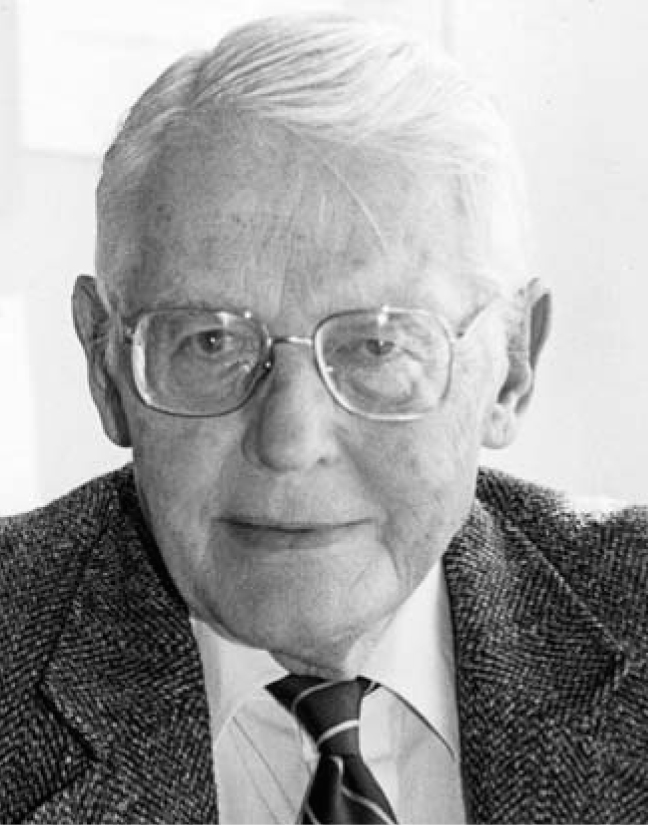George T. Reynolds
DOI: 10.1063/1.2138439
George T. Reynolds, whose insights led to developments in elementary particle physics, environmental science, and biological physics, died of cancer on 19 April 2005 at his Skill-man, New Jersey, home.
Born on 27 May 1917 in Trenton, New Jersey, George never strayed far from his central New Jersey roots. He received his bachelor’s degree in physics from Rutgers University in 1939 and his physics PhD, under Walker Bleakney, from Princeton University in 1943.
George’s thesis work was on shock waves, so he was quickly sought out for the Manhattan Project, which he refused to join. Instead, he tried to en-list in the US Navy but was turned down because he wore eyeglasses. Not one to take “no” for an answer, George succeeded in having that policy waived. After he enlisted, he married, and then awaited orders. To his dismay, he was immediately assigned to Los Alamos, where he worked with George Kistiakowsky on the Fat Man plutonium bomb. He was among the first sent to Hiroshima and Nagasaki to assess damage. He received the Army—Navy Certificate of Appreciation for his contributions.
In 1946 George accepted a faculty position at Princeton, where he remained until the end of his life. Influenced there by John A. Wheeler, he formed a group to study the high-energy-particle aspect of cosmic rays. By 1949 he had begun staffing the group with cloud-chamber experts Ronald Rau from Caltech and Joseph Ballam from the University of California, Berkeley, for a major effort in high-altitude experiments at Echo Lake, Mount Evans, Colorado. George had a knack for identifying young talent. In 1952 he hired a promising young PhD from the University of Chicago, Sam Treiman, as an instructor. He also brought Jack Keuffel, Georgio Salvini, Riccardo Giacconi, Val Fitch, and Jim Cronin on board as members of the cosmic-ray group.
George tried to grow large organic scintillation crystals—because of the low cosmic-ray flux—as ionizing particle detectors. To get around cracks in the crystals, he tried dissolving the organic scintillator in a liquid. Contrary to the prevailing theory of scintillation, the solution’s scintillation efficiency was comparable to that of crystals. George and his collaborators, Salvini and Francis B. Harrison, reported their results in 1950 in a letter to the editor of the Physical Review. Liquid scintillators soon became pervasive across the sciences.
By the 1960s, the group’s activities centered on particle experiments at Brookhaven National Laboratory’s Cosmotron, Berkeley’s Bevatron, and the Princeton-Penn Accelerator. George, while pursuing his own studies in luminescence, continued as director of the cosmic-ray lab (later the elementary-particles lab). He created a wonderful place to do physics, where professors, postdocs, and graduate students mixed in a friendly and productive atmosphere.
Protein crystallography was becoming important in the late 1960s, but it involved slow, cumbersome filming of diffraction patterns. George realized that image intensifiers could be used to acquire diffraction data, and with graduate students Thomas Minor, James Milch, and one of us (Gruner), he began the development of automated x-ray detectors. That work led to the CCD detectors that now collect most of the world’s protein-structure data.
When concern for the environment began sweeping the world’s university campuses in the late 1960s, George, along With Marvin Goldberger, Irvin Glassman, and Robert Jahn, persuaded Princeton’s president and provost to establish a new research unit independent of the university’s department structure, at a time when Princeton had few nondepartmental units. That unit, the Center for Environmental Studies, was established in 1971. One of George’s memorable phrases was that a university needed to guard against “the hardening of the categories.”
George served as the first director of the center. At considerable personal cost, he championed its independence and established standards of excellence and internal peer review. He guided and encouraged the center’s first investigators as they chose unconventional cross-disciplinary research topics—in energy conservation in buildings, indoor air quality, the connection between nuclear power and nuclear weapons, and the values involved in environmental decision making. George inspired people with the adage that a good university researcher should write only the first or the last paper on any subject.
Around 1970, George, in his middle fifties, changed career directions and took an interest in biology. He became deeply committed to working with his own hands on what he then called “weak light,” a light-hearted unifying concept that captured his early work on cosmic rays and his later work on bioluminescence. Seeking to combine his love of sea and science, George sought and received an appointment with the Marine Biological Laboratory in Woods Hole, Massachusetts, where he spent many summers studying marine luminescence. In his last decade, he focused on luminescent phenomena pertaining to hydrothermal vents in midocean ridges. During that time, he was an adjunct scientist at Woods Hole Oceanographic Institution.
George was blessed with the ability to foresee scientific opportunities and worked tirelessly to bring those to fruition. His colleagues and students, and his family—to which he was devoted—remember him as the person who saw the way and then made it a reality.


More about the Authors
Sol M. Gruner. Cornell University, Ithaca, New York, US.
Pierre A. Piroué. Princeton University, Princeton, New Jersey, US.
Robert H. Socolow. Princeton University, Princeton, New Jersey, US.




